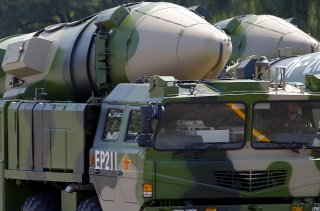China and Russia: Two Big Threats the U.S. Military Can't Ignore
Russia and China are working together to enhance their weapons and partner militarily. What will Joe Biden do about it?
Meanwhile, Russia and China officially support space arms control even as they both view space as a war-fighting domain. They both pursue counter-space systems to neutralize or deny U.S. space-based services—military as well as commercial. China and Russia have developed space warfare capability including three types of ground-launched anti-satellite missiles, anti-satellite lasers and maneuvering satellites.
On Oct. 6, 2020, former Secretary of Defense Mark Esper rolled out a new 25-year road map with a goal of 355 manned ships and half as many unmanned surface and subsurface ships. His plan calls for fewer large carriers and more submarines in a Navy of 500 ships or more. He also increased the Virginia attack submarine force from 70 to 80 boats. With unlimited range, attack submarines can prowl the globe, shadowing Russian and Chinese ICBM submarines or delivering devastating missile barrages. They covertly collect intelligence that cannot be obtained in any other way. Six years ago, General Dynamics was awarded a $17.8 billion contract to build 10 Virginia-class submarines to replace the Los Angeles class, which has been in service since 1976. Esper proposed to increase the production of Virginia class submarines to three a year, up from the current two.
The U.S. Navy is also committed to building 12 Columbia-class nuclear ballistic submarines to replace the Ohio-class submarines. The sole mission of the Columbia class is strategic nuclear deterrence, for which it carries long-range submarine-launched ballistic missiles. They provide the most survivable leg of America’s strategic nuclear deterrence, with 70 percent of the nation’s accountable nuclear warheads, and constitute its only assured second-strike capability. Our greatest danger lies between now and 2031 when the first of the Columbia-class submarines will be deployed. That’s a long period of terrifying vulnerability. Nothing should be done to slow the development and deployment of the Columbia or Virginia class, and we should support any opportunities to speed it up.
The best way to prepare for war is to be prepared to win it. We need to stop underfunding the military, especially in such key areas of research as non-conventional war, space, cyberwar and artificial intelligence. War is changing, and we need to change with it. We cannot expect success fighting tomorrow’s conflicts with yesterday’s weapons.
Former Secretary of the Navy J. William Middendorf’s new book, The Great Nightfall: How We Win the New Cold War, (thegreatnightfall.com) warns of the threats we face, particularly from China.
Image: Reuters.

